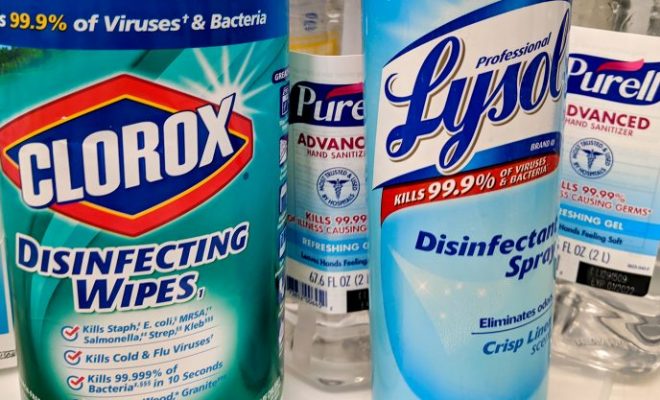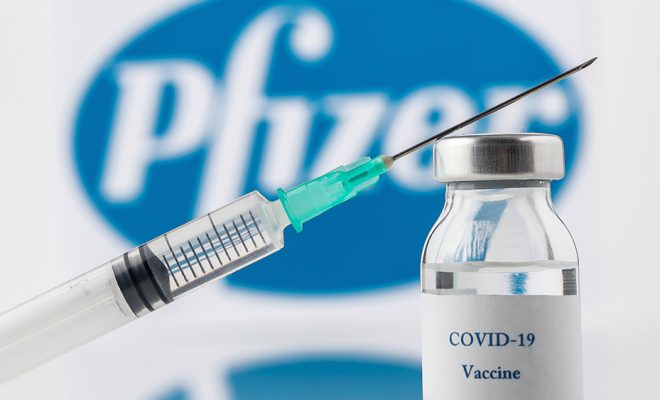Researchers Sound Alarm About Harmful Chemicals in Common Disinfectants

Disinfectant use has exploded during the coronavirus pandemic as people try to keep their hands and surfaces clean. But one family of cleaning chemicals is receiving scrutiny for potential health concerns.
Quats, or quaternary ammonium compounds, are charged molecules that can kill bacteria, fungi and viruses. Quats are effective disinfectants, but some researchers are raising alarm given recent research on the compounds’ possible human health and environmental effects, including fertility issues, endocrine disruption, occupational asthma, marine toxicity and potential to spur antibiotic-resistant bacteria.
And, while industry defends quats as safe, some states are taking notice and looking into regulations.
Bacterial resistance
The pandemic has increased demand for products like Lysol wipes that use quats as active ingredients: Sales of Lysol wipes were up nearly 50% in spring of 2020 compared to 2019. Other cleaning products are also in high demand — aerosol disinfectant sales as a whole have doubled in 2020 in the U.S., a large fraction of which also contain quats.
All those additional sales mean quats are becoming more present in the environment. “We’re in an era now where the concentration [of quats] is certainly higher than ever before,” William Arnold, an environmental engineer at the University of Minnesota, told Environmental Health News (EHN). He published a paper in June that revealed an increased load of quats may be ending up in wastewater plants, with some worrisome implications. Quats can end up in wastewater plants after they’re flushed down the drain — at the levels of use during the pandemic, some plants can’t keep up, so quats have the potential to pollute waterways. There, they might disrupt marine food chains, as quats have been found to be toxic to small invertebrates like plankton in lakes.
The ingredients also may be spurring antibiotic-resistant germs, Arnold said.
Bacteria are constantly working to shore up their defenses against the antiseptics we use. “We’ve had an 80- or 90-year head start, but we really need to keep innovating” to stay ahead of microbial evolution, Kevin Minbiole, a Villanova University chemist who studies how quats affect bacteria and viruses, told EHN.
Quats work like spears, penetrating the shell on the outside of a bacteria or virus. But some bacteria are getting better at recognizing quats and getting rid of them, or becoming resistant, said Minbiole. He and his collaborator, Emory University chemist William Wuest, are experimenting with new antimicrobial ingredients and recently patented their own quats that can mount multiple attacks on a single microbe. These quats are likely even more effective antiseptics than current quats on the market, but the new chemicals haven’t yet been tested for safety, so it’s not clear how their health or environmental impacts might differ, or not, from current quats, according to Wuest.
But the germs may be one step ahead. As they encounter quats and other antiseptics, bacteria can develop broad, rather than specific, resistance. These new bacterial shields, which evolved to block attacks by antiseptics, might also protect them against other threats, including the antibiotic medications doctors prescribe to help fight serious infections.
It’s called cross resistance: when changes bacteria make to get around one threat make them better suited to survive other threats, too. “Those changes make bacteria capable of surviving different compounds, different chemicals that it hasn’t seen before,” Beatriz Pereira, a recent graduate student in microbiology from University of California, Davis, told EHN.
In lab experiments, Pereira has seen bacteria develop resistance to certain quats, even when she only exposes them to low concentrations of the chemicals. The bacteria shore up their defenses, strengthening their outer membrane — a good way to develop cross resistance to other chemicals as well. It’s not clear whether bacteria are yet developing resistance in the wild in response to current levels of quat pollution, or even how much quat pollution currently exists. But to Pereira, these lab experiments alongside a growing body of evidence suggest that the best way to respond to the problem of antibiotic resistance may be not to develop new quats, which might cause the same problem of antibiotic resistance eventually, but to reconsider whether we should be using them at all, at least in some products.
Birth defects and infertility
Theresa Hrubec, a biologist at Virginia Tech, has also been publishing work on the potential risks of quats — work that started by accident. While she was using mice to study potential side effects of medications, she noticed that some mice in her control group, the mice that weren’t exposed to any medication, were developing birth defects. After ruling out the possibility that she had switched the groups, she found a potential explanation: the facility had recently started using quats to disinfect her lab. The floors were mopped daily, the walls wiped down weekly, and anytime a box of mice was opened, it was wiped down with disinfectant. The mice were all being unintentionally dosed with quats, Hrubec told EHN. And she wasn’t the only researcher who had seen problems with mice and quat disinfectants: Patricia Hunt, a researcher at Washington State University, had seen similar problems with her mice.
Hrubec and Hunt have since published several studies that link quats to health problems in mice, from birth defects to decreases in fertility. For each of the studies, mice were fed a mixture of two common quat disinfectants at high doses for several weeks before being examined for either fetal birth defects or signs of decreased fertility.
Mice that were exposed to quats were more likely to develop neural tube defects, an early-stage birth defect. And doses of quats decreased the number and size of litters born as well.
How exactly quats might cause birth defects is still unknown, according to Hrubec. She has a few theories. Endocrine disruption might be to blame — Gino Cortopassi, who collaborated with Hrubec, found that one quat, although not the same chemical Hrubec used in her research, can bind to hormone receptors. The same lab also found that quats appear to affect how mitochondria function, which can cause a litany of problems in cells.
Inflammation might be another possible explanation. Quats are suspected to cause occupational asthma — exposure to a toxic or irritating chemical that results in lung inflammation. Japanese researchers found in 2010 that mice exposed to quats at high concentrations by inhalation saw cell death and increased levels of inflammation. However, human studies observing quat exposure and occupational asthma have had mixed results, with some researchers arguing that quat exposure hasn’t been definitively linked with lung problems.
Most of the research by Hrubec and her collaborators is done in mice, so quats may not have the same effects on humans. Figuring out how quats might be impacting humans is a much more complicated job. In a pre-print, published last year but not yet reviewed by outside experts for accuracy, Hrubec and her collaborators performed a monitoring study of a small group, 43 people. They detected quats in 80% of the study participants, and quat levels in the blood were associated with higher levels of inflammation and decreased mitochondrial function. The results are still preliminary, but it is among the first research to attempt monitoring quat levels in humans.
Dose disagreement
Not everyone agrees about how the research is being done. In a letter to the editor in response to one of Hrubec’s early studies, Keith Hostetler, an industry representative, raised concerns about the experiment’s design. One critique was the dose level — according to Hostetler, the level of disinfectant fed to the mice would be the equivalent of a 155-pound adult drinking about 1.5 quarts of disinfecting solution daily.
But toxicology studies are pretty typically performed with high doses at first, before being extrapolated down to more realistic doses, according to Heather Patisaul, a biologist at North Carolina State University who studies toxicological effects of hormone-disrupting compounds.
She was not involved in Hrubec’s studies.
“Complaining that the dose is too high and the sample size is too low is a common industry response,” Patisaul told EHN via email. In this case, she said the dosage was particularly high for some groups. However, Patisaul also notes that Hrubec saw birth defects in fetuses when the father was fed less than 1/15 the dose Hostetler mentioned, which she said is more compelling evidence that quats might cause harm.
Still, “neither [dose] is anywhere near a human-relevant range,” Patisaul said, so the results do not definitively show that quats could harm human health with normal levels of use.
The doses were high in order to determine whether quats warrant more research, said Hrubec, adding that many mice that were not fed quats, but were merely present in rooms where quats were used, were also found to develop birth defects. To her, this suggests that the disinfectants present in the lab from regular disinfecting were still enough to trigger health problems.









